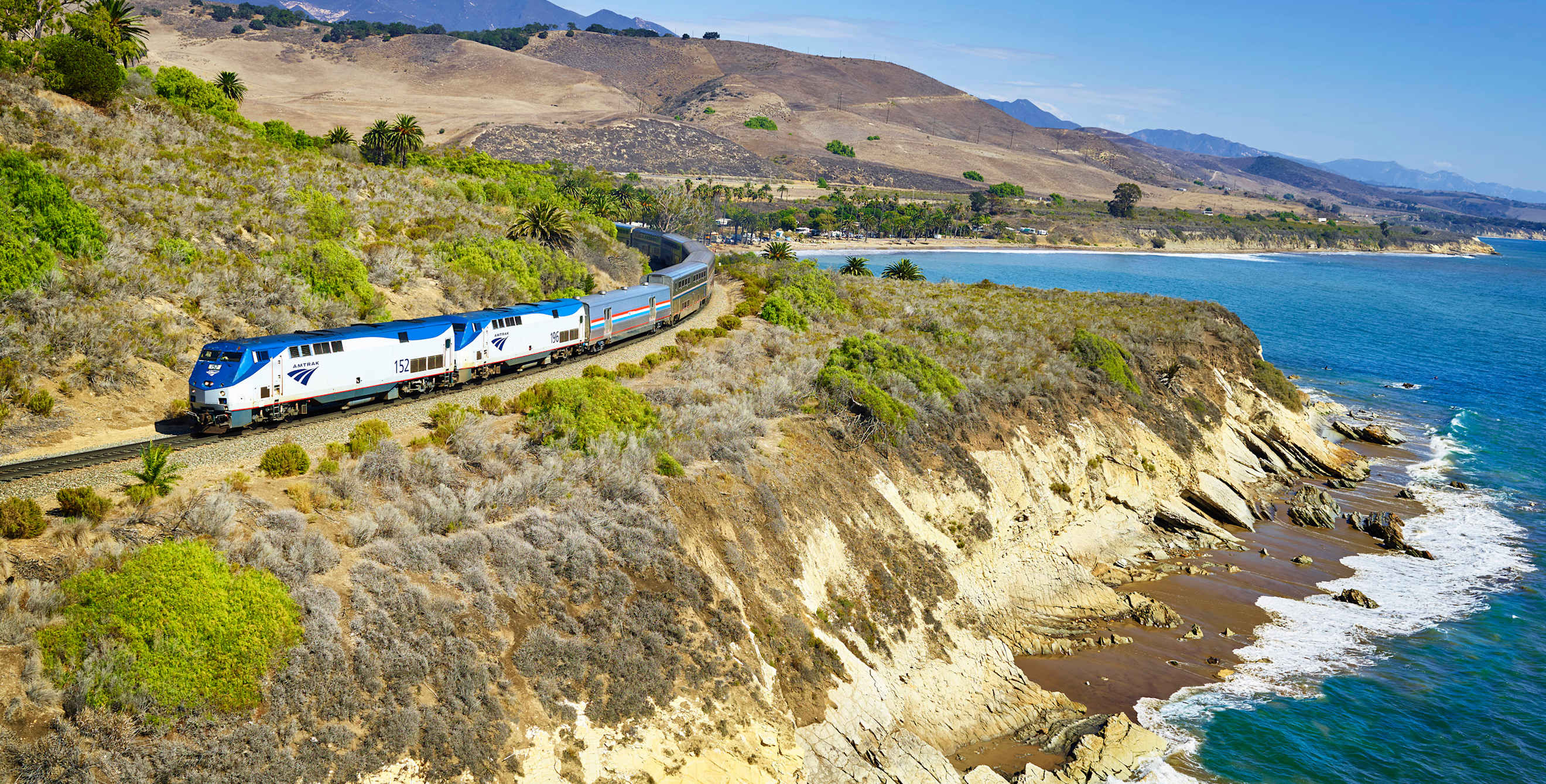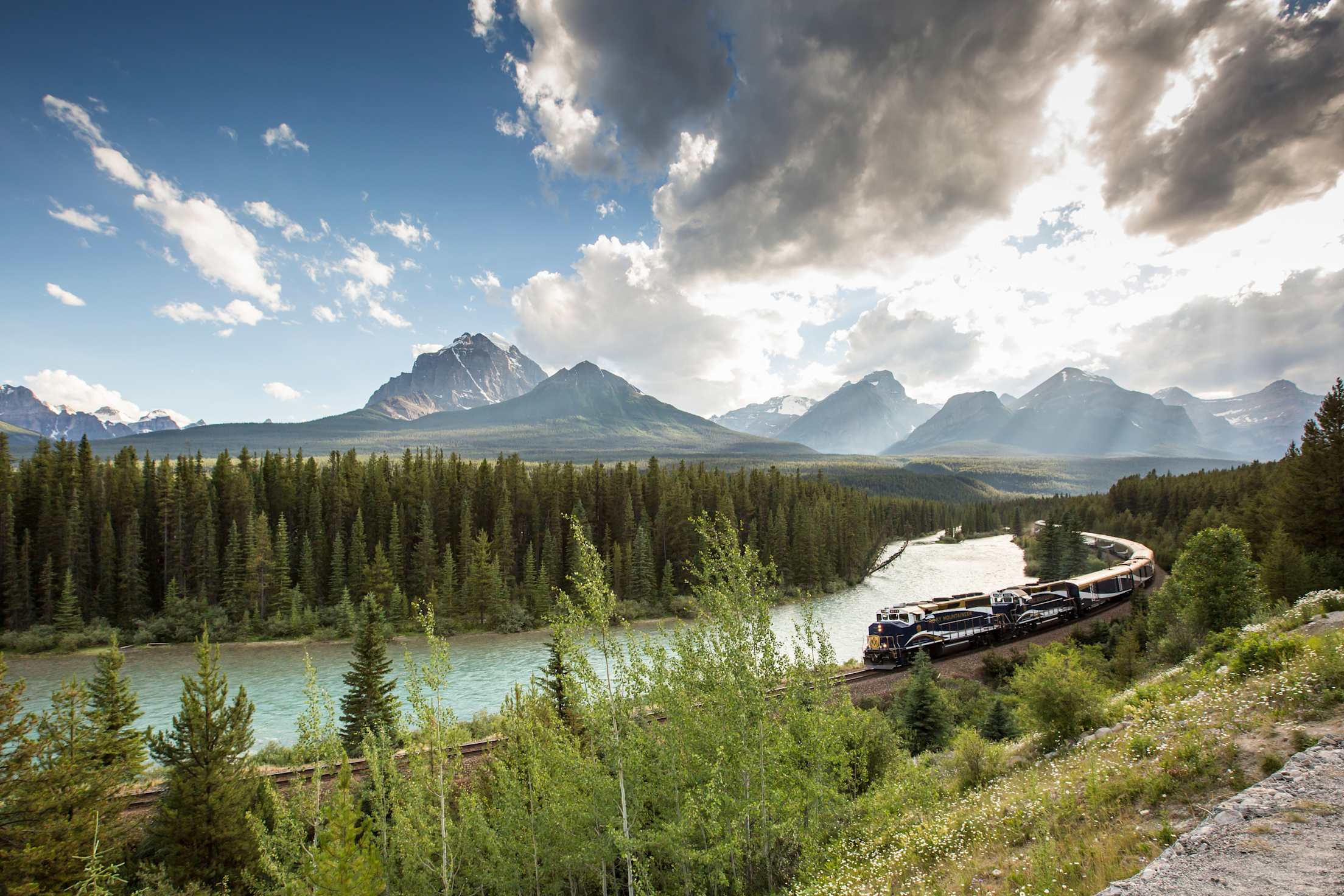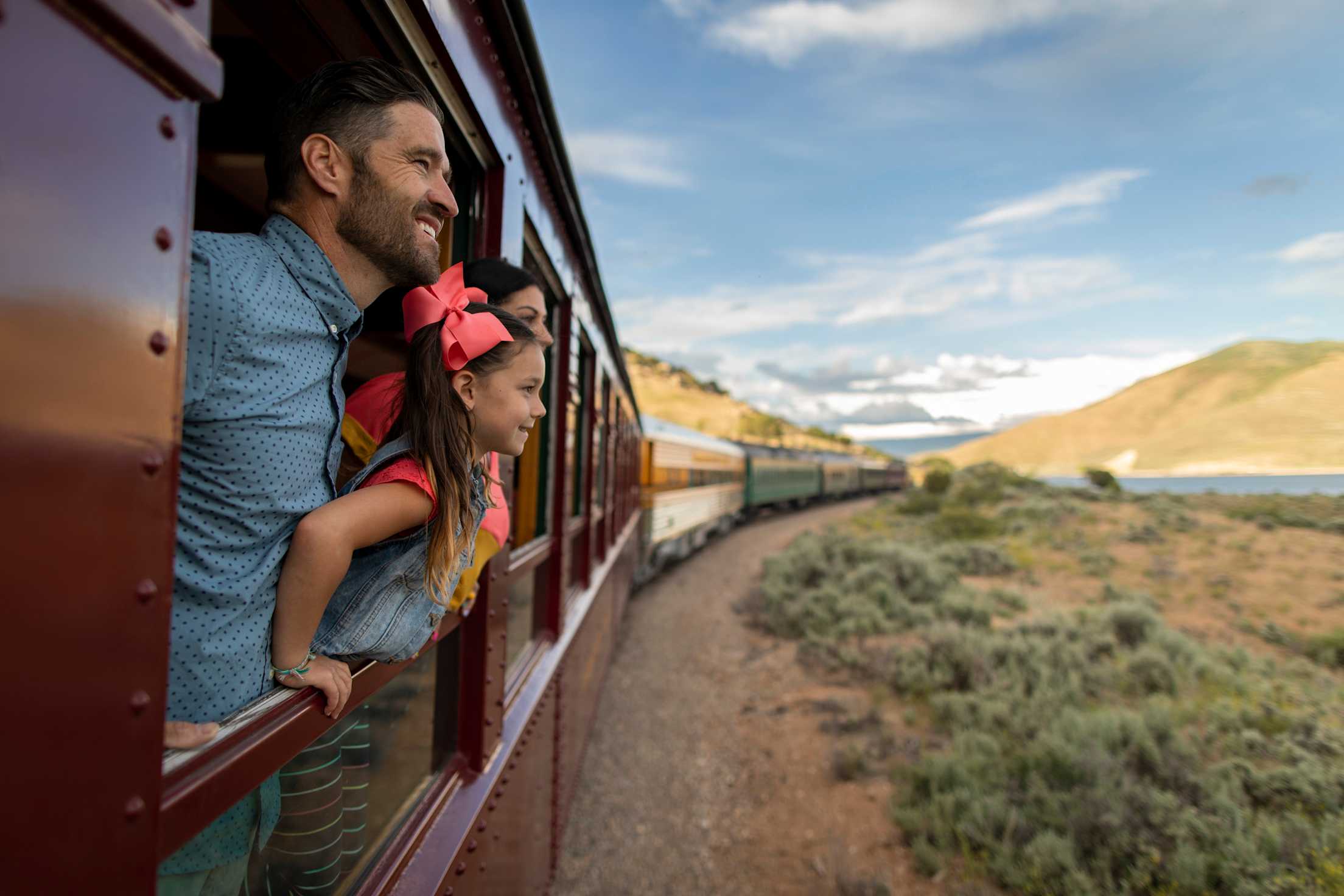
11 Best Train Rides in the West
Ride the rails on these scenic routes.

Four ceremonial spikes, two of them gold, dropped into a wooden tie in Promontory, Utah. Then a hammer struck an ordinary iron spike, setting off cannons in New York City and all the fire bells in San Francisco. Completion of the transcontinental railroad in 1869, and the spread of other rail lines around the United States, transformed the nation. Trains changed how and why we travel, what we buy, where we live—who, in fact, we are.
Rails linked the coasts, connecting states that had at times been united in name only. By 1870, a trip from Omaha, Neb., to Sacramento that once required several months in a covered wagon could be made behind a steam engine in just four days. Trains both transported fortunes and created them.When the train arrived, progress had pulled in.
Though cars and airplanes usurped the reign of trains, railways retain their hold on the imagination. Only a grouch has no affection for a train. Compelling rides still abound: passenger routes geared to long-distance commuting, tourist rails that travel through postcard landscapes, entertainment-focused excursions for which the destination is not the point. The trips that follow are a sample of that bounty, ranging from the country’s iconic rides to beloved local jaunts. Each shows a different side of train mystique—that allure in the soulful sound of a locomotive’s whistle or in the sight of an old engine, chest puffed, tossing steam over its shoulder as its conductor calls out, “All aboard!”
Coast Starlight
Los Angeles–Portland
Reasons to choose this overnight train rather than a plane hop are as varied as its passengers. “No security lines!” an older gent declares as the train departs Los Angeles. A young mother nods, relieved that her kids can move around. In another car, a rail buff shares his enthusiasm with a commuter tired of traffic. The Coast Starlight lives up to both halves of its billing: You can gape at the Pacific or gaze at the night sky from the observation car. The ride provides hours of great sights, among them the horseshoe turn near San Luis Obispo, California, during which the engine looks down upon the last car, and a Cascade Range stretch where you pass a waterfall unreachable by auto. But what lingers most is a sense of relaxation. It’s dark when you arrive in Oakland, onetime terminus of the transcontinental railroad. You pull down your bunk and let the rhythm of the rails rock you to sleep. In the morning, you’ll awake to the green of Oregon.
California Zephyr
Salt Lake City, Utah–Emeryville, California
Along the Great Salt Lake, the tracks parallel I-80, an asphalt alternative that hardly rivals the pleasures of the rail. Among the upsides of not driving: comfy sleeping cars and a Sightseer Lounge with picture windows. Rest up at night, because the Zephyr rumbles through the finest scenery by day, including the Humboldt River Valley in Nevada and the pine-mantled Sierra. On its curling path over the Donner Pass, the diesel engine seems to slow, as if in deference to that doomed long-ago party. An auto could get you up and over faster. But the magic of this 17-hour overnight journey is that it leads you through the past even as it propels you forward.
Empire Builder
Portland, Oregon–West Glacier, Montana
To ride this overnight passenger train, which takes 141/2 hours in one direction as it follows major portions of the Lewis and Clark trail, is to experience the railroad as a form of time travel. The list of landmarks it passes reads like excerpts from the famed explorers’ log. About 60 miles east of Portland rises Beacon Rock, an oversize outcrop in the Columbia River Gorge that Lewis and Clark christened in the early 1800s. Farther on is Wishram, Wash., where the pair gaped at abundant salmon fishing grounds and helped arrange a trade parley between the Wishram and Nez Perce Indians. Much of the landscape consists of untamed plains, as it did when railroad tycoon James J. Hill, the “empire builder,” ran the operation. The ride builds in drama as you move east. The Sightseer Lounge is an ideal viewing platform for Montana’s sapphire lakes and craggy mountains. Poor Lewis and Clark missed them: Their party split and went its separate ways 120 miles short of this magical backdrop, which today’s travelers know as Glacier National Park.
The Skunk Train
Fort Bragg–Willits, California
When it appeared 134 years ago, this railroad was known as the California Western. Odoriferous gasoline engines, which came into service four decades later, helped inspire a more distinctive sobriquet. Today, the Skunk Train draws on steam or diesel power (depending on the day and the season), and the rides— some just two hours each way—are nothing to sniff at. Restored passenger cars and a revitalized depot have brought new shine to timeworn facilities; an added snack car stocks local microbrews and wines. Riders can sightsee from an open-air observation car as the train follows the route of an old logging railroad through aspens, oaks, and ancient redwoods. The towering trees, some centuries older than the oldest railway, offer a lesson in perspective. Regardless of your vantage point, you’ll soon be enveloped by clean-scented forest.
Grand Canyon Railway
Williams, Arizona–Grand Canyon National Park
Built to transport gold ore from nearby mines, the original Atchison, Topeka & Santa Fe Railway proved more lucrative when transporting tourists towards the rim of the Grand Canyon, named a national park 18 years after the train began running. For seven decades trains made the 65-mile trip from the town of Williams to the South Rim, until the rise of the automobile led to the line’s shutdown in 1968. In 1989 the Grand Canyon Railway reopened with restored steam engines, antique railway cars, and historic depots. Today the ride, two-plus hours each way, takes passengers through landscapes as varied as Ponderosa pine forests, where they might see elk, mountain lions, and deer; and high desert, where pronghorn sheep, bald eagles, and California condors are not uncommon. (The steam engines, retired in 2008 for environmental reasons, were revived to travel an eight-mile round-trip route only on major holidays, powered by filtered recycled cooking oil and reclaimed snowmelt.) In the winter the company runs the Polar Express with reconditioned Pullman Coach cars, ferrying wide-eyed, pajama-clad children through a re-created “North Pole” complete with cookies, hot chocolate, and a visit from Santa.

Rocky Mountaineer
Vancouver, British Columbia–Calgary, Alberta
Uniting all of Canada by rail required impressive acts of engineering. But it’s the views that mark your memory on the two-day, one-night First Passage to the West trip, which follows the route that first connected British Columbia to the rest of the country in 1885. On the trip to Banff National Park, the Canadian Rockies—serene, serrated, snowcapped—loom large over a landscape of calm lakes and frothing rivers, where pine-forested ground seems to go on without end . . . until the terrain rises and the earth turns arid, as if the diesel train were now a moon rover. The Mountaineer’s SilverLeaf Service isn’t shabby either, with complimentary non-alcoholic beverages and meals brought to your seat. (More expensive GoldLeaf Service includes three-course meals and access to a two-story glass-domed observation car.) Take-your-breath-away moments abound—as when the line passes the rushing waters of Hell’s Gate, the narrowest point on the Fraser River, and glides through western Canada’s renowned Spiral Tunnels, looping mountain passages that engineers dreamed up when nature offered no easier way.
Mount Hood Railroad
Hood River–Parkdale, Oregon
Like pioneers of the covered wagon era, riders on this line’s Parkdale Excursion Train make their way through the Columbia River Gorge and along the Hood River, albeit with a few more modern comforts. Diamond class service on the four-hour round-trip offers an air-conditioned dome car with skylights and picture windows for unimpeded views. The scenery is an eyeful from the outset, as the diesel engine rolls from the mouth of Hood River through pear orchards and pine forests en route to its turnaround at the base of Mount Hood. During the stopover, which lasts roughly an hour, you’ve got time for an ice cream at an old-fashioned parlor, a pint at a brewpub, or a cappuccino at a café. At the produce market, pick up the fixings for a picnic—a rustic style of dining well-known to early explorers.
Virginia & Truckee Railroad
Virginia City–Carson City, Nevada
For all the romance we attribute to early railways, most were mercenary ventures, engines of economic growth. Consider this steel link in the eastern Sierra Nevada range, a Gold Rush–era railroad built to ferry fortunes in silver and gold from the Comstock Lode. At its most robust during the 1870s, the V&T was known as the wealthiest short line in the world. It spurred development across Nevada and turned its shareholders into titans who routinely netted more than $100,000 a month. But by the 1920s, a highway had become the people’s choice for transportation; in the ’30s, competition from trucking dealt the line an even more serious blow. In 1950 the V&T died—and remained a ghost rail until 1976, when it returned to life as a tourist train. Along the winding, three-hour Carson round-trip route, riders frequently see mustangs roaming the folds of the Nevada foothills. Memories of the Gold Rush literally surround passengers as the train chugs through a pair of tunnels dug mostly by hand, with picks and shovels, by Chinese laborers and some of the same workers who toiled in the mines.

Heber Valley Railroad
Heber City–Vivian Park, Utah
The railway affectionately known as the Heber Creeper gets its moniker from its locomotives’ inching pace. Despite the nickname, on its Provo Canyon Limited route (one of 16 themed trips), the train can outrun the current of the nearby Provo River, which appeared in the Robert Redford movie Jeremiah Johnson. The three-hour round-trip gives you leisure to spot foxes, hawks, and deer in the canyon and anglers in the water, fly casting for trout. Roughly five miles outside Heber City you glide past Soldier Hollow, the cross-country skiing and biathlon venue of the 2002 Winter Olympics, where some athletes approached 20 mph, the top speed of this diesel train.
Alaska Railroad
Anchorage–Fairbanks, Alaska
During the region’s darkest months, when the temperature plunges and the daylight rushes by, the Aurora Winter Train runs its weekend service, an otherworldly trip through a land transformed. Rivers shiver, their faces partly frozen. Valleys slumber under thick blankets of white. Progress can be slow, as the train, with just three cars pulled by a diesel engine, stops to take on passengers at tiny local stations. It takes 11½ hours to go one direction. But the traveler’s heart races as the train crosses a steel arch bridge some 300 feet above Hurricane Creek or pulls into Talkeetna station, Denali rising in the distance. Though the landscape barely stirs, the stillness is deceptive. The engineer may brake, a long way from nowhere, to avoid spooking a herd of caribou or wait for a moose to clear the tracks.
Mt. Rainier Scenic Railroad
Elbe–Mineral, Washington
Originally used for hauling lumber when its track was laid in 1903, this railroad snaking through the foothills of the Cascade Range was built to meet the demands of its job and its terrain. The trains’ flexible wheels could handle sharp bends, and their slow-churning, powerful engines excelled at lugging heavy loads at low speeds. Steam service has run on these rails longer than anywhere else in the Pacific Northwest. Though the present-day company (which took over the track in 1980) pulls passengers, not product, it travels the same path—one with more curves than straightaways. Along the two-hour roundtrip route, riders enjoy short, steep climbs over fir-blanketed hills, a long bridge crossing over the Nisqually River, and stirring views of Mount Rainier. From the depot in Elbe, a worthwhile 10-minute drive takes you to the maintenance shop, where skilled mechanics ensure that the museum-worthy equipment remains very much alive.